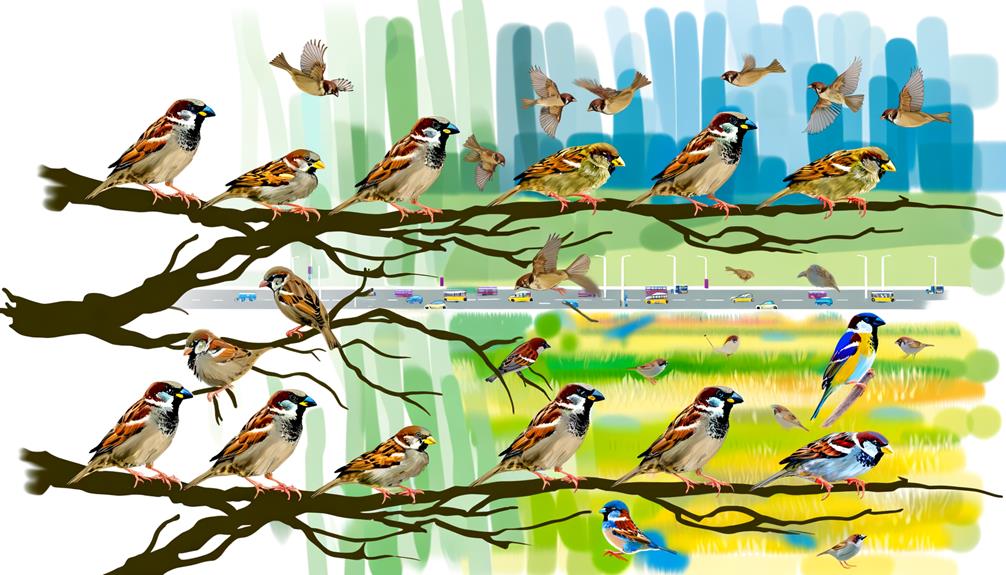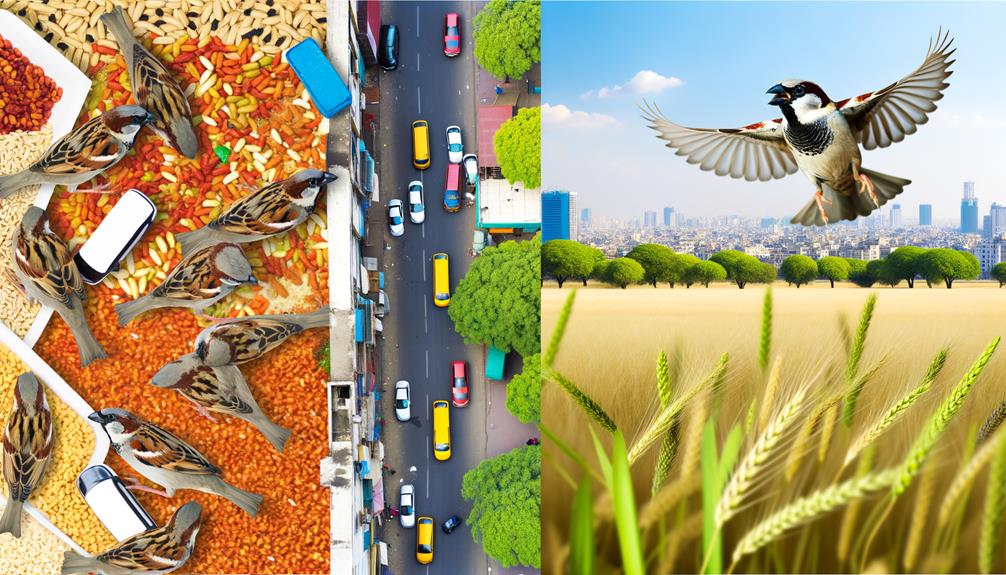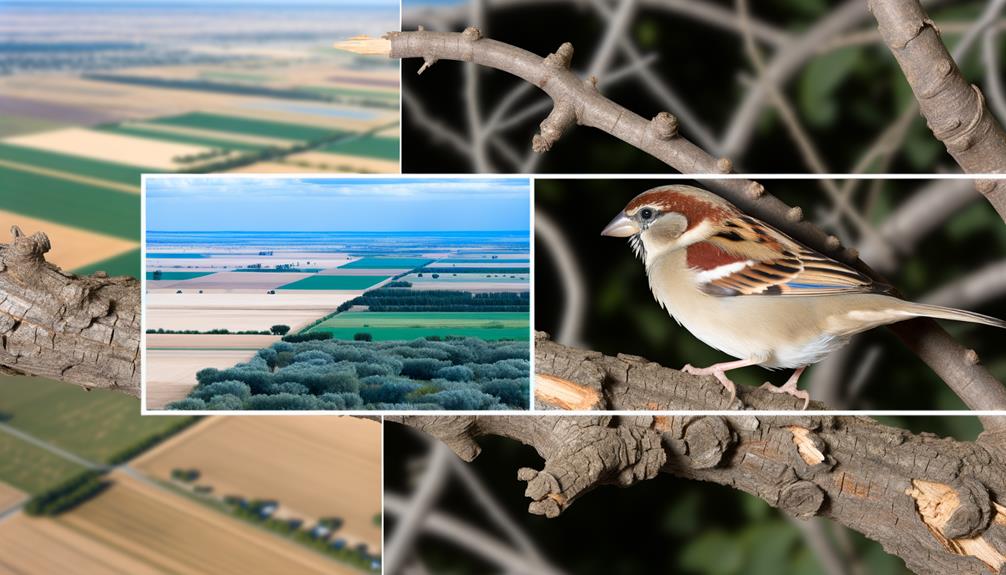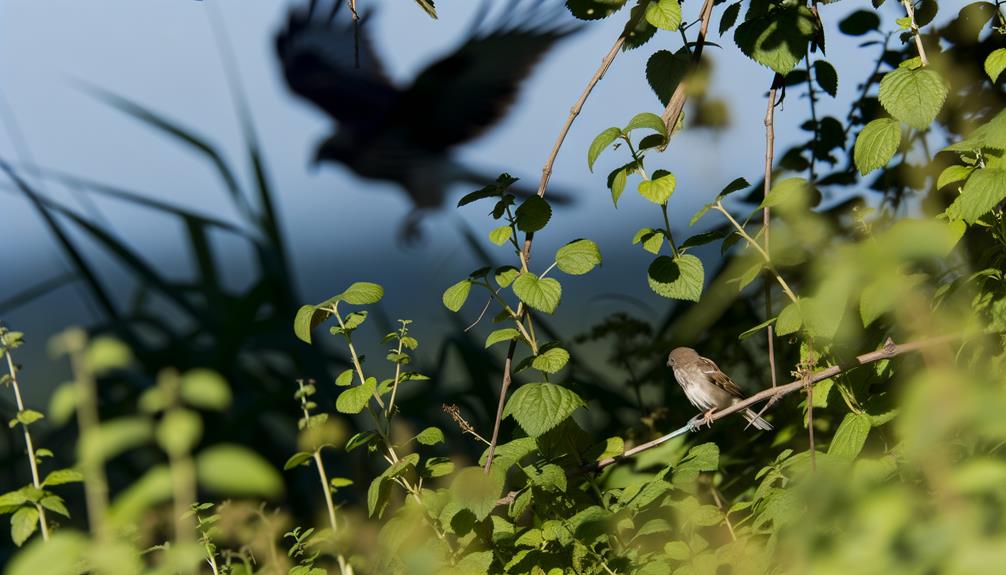How Far Will Sparrows Travel for Food?
Sparrows generally forage within a radius of 1 to 2 kilometers from their nesting sites. This range is influenced by habitat type, food availability, and predation risk.
Urban sparrows tend to travel shorter distances compared to their rural counterparts. Seasonal changes significantly impact foraging behavior; distances extend during winter due to food scarcity and contract during spring and summer.
Flight patterns and energy expenditure are finely tuned to optimize foraging efficiency. Predation risks also play an essential role, with higher risks limiting foraging range.
Adaptive strategies such as opportunistic feeding and social learning enhance their survival, revealing intricate behavioral dynamics.

Key Takeaways
- Sparrows typically forage within 1 to 2 kilometers from their nesting sites.
- Urban sparrows travel shorter distances for food compared to their rural counterparts.
- During winter, sparrows extend their travel distances due to limited food availability.
- Low food density can increase sparrow foraging ranges beyond the usual limits.
- Predation risks and habitat type significantly influence sparrow foraging distances.
Sparrow Species Overview

Sparrows, frequently observed across diverse habitats, encompass a variety of species within the family Passeridae, each exhibiting distinct morphological and behavioral traits.
These small passerine birds, such as the House Sparrow (Passer domesticus) and the Eurasian Tree Sparrow (Passer montanus), are characterized by their stout bodies, rounded wings, and conical beaks adapted for seed consumption.
Morphometric data reveal average body lengths ranging from 12 to 18 centimeters and weights between 24 to 40 grams.
Behaviorally, sparrows are highly social, often forming large flocks. Their vocalizations, primarily composed of simple chirps and calls, play vital roles in communication and territorial defense.
Understanding these species' ecological roles and adaptability provides insight into their foraging behaviors and spatial distribution.
Typical Foraging Range
The typical foraging range of sparrows, influenced by factors such as species-specific behavior, habitat type, and food resource availability, generally extends to a radius of approximately 1 to 2 kilometers from their nesting sites. This radius allows them to optimize energy expenditure while accessing diverse food sources.
Detailed observations highlight several influencing factors:
- Habitat Complexity: Dense vegetation or urban structures can limit or extend the foraging range.
- Seasonal Variations: Resource scarcity during winter can push sparrows to travel further.
- Predation Risk: Areas with high predator presence might restrict the foraging distance.
Data analysis reveals that sparrows exhibit remarkable adaptability in their foraging strategies, balancing the need for sustenance with environmental constraints. Understanding these patterns is essential for conservation and urban planning efforts.
Urban Vs. Rural Foraging

Urban and rural environments present distinct differences in resource availability, which greatly influence sparrow foraging behavior patterns.
In urban areas, anthropogenic food sources and feeder stations result in shorter travel distances and higher foraging site fidelity.
Conversely, rural sparrows often exhibit broader foraging ranges due to the dispersed and seasonal nature of natural food resources.
Resource Availability Differences
Significant disparities in resource availability between urban and rural environments profoundly influence the foraging behavior and travel distances of sparrows. Urban areas typically offer abundant and diverse food sources due to human activities, leading to shorter foraging distances.
Conversely, rural settings present more scattered and seasonal resources, requiring longer travel.
- Urban environments: Consistent food supply from bird feeders, waste, and ornamental plants.
- Rural landscapes: Dependence on natural cycles, with food availability tied to agricultural seasons and wild flora.
Data analysis shows that studies indicate urban sparrows travel an average of 1.5 km for food, while rural sparrows may cover up to 5 km.
These variations underscore the adaptive strategies sparrows employ to maximize foraging efficiency in differing habitats.
Foraging Behavior Patterns
Contrasting foraging behavior patterns between urban and rural sparrows reveal significant adaptations to their respective environments. Urban sparrows often exhibit reduced foraging distances due to abundant food sources, while rural sparrows traverse greater distances to locate sustenance. The following table highlights key behavioral differences:
| Behavior | Urban Sparrows | Rural Sparrows |
|---|---|---|
| Foraging Distance | Short (within 50-100 meters) | Long (up to 5 kilometers) |
| Food Sources | Human-provided, waste, feeders | Natural, dispersed vegetation |
| Foraging Time | Daytime, consistent intervals | Varied, dependent on daylight |
Urban sparrows exploit anthropogenic resources, resulting in altered diurnal rhythms and spatial constraints. Conversely, rural sparrows rely on natural foraging strategies, adapting to seasonal and ecological variability. These behavioral adaptations underscore the plasticity of sparrow foraging in response to environmental pressures.
Seasonal Variations
Seasonal fluctuations heavily influence the foraging behavior and travel distance of sparrows as they adjust to changing food availability and environmental conditions throughout the year. During winter, reduced daylight and colder temperatures often compel sparrows to journey farther in search of sustenance.
In contrast, spring and summer offer abundant food sources, resulting in shorter foraging trips. Autumn's shifting phase also affects sparrow movement patterns as they get ready for winter scarcity.
- Winter: Extended travel distances due to limited food sources and harsh conditions.
- Spring/Summer: Brief foraging trips due to ample food availability.
- Autumn: Moderate travel distances as sparrows adapt to evolving conditions.
Seasonal changes profoundly modify sparrow foraging strategies, showcasing their remarkable adaptability to environmental changes.
Food Availability Impact

The availability of food sources directly influences the foraging range and travel behaviors of sparrows. This is evidenced by shifts in their movement patterns in response to fluctuating resource distributions. Empirical studies reveal that sparrows exhibit increased travel distances when food scarcity is prevalent. They often expand their foraging radius to encompass more diverse habitats. Data from GPS tracking devices indicate a direct correlation between low food density and extended travel ranges, sometimes exceeding 10 kilometers.
Conversely, in environments where resources are abundant and evenly distributed, sparrows display more constrained and localized foraging behaviors. This adaptability underscores the species' resilience and flexible foraging strategies, which are critical for survival in varying ecological conditions. Understanding these patterns is essential for avian conservation efforts.
Energy Expenditure
The energy expenditure of a sparrow is an important factor influenced by the balance between caloric intake and output, where maintaining equilibrium is essential for survival.
Flight efficiency is determined by variables such as wing morphology and atmospheric conditions, which directly affect the distance a sparrow can travel.
Additionally, seasonal travel patterns notably alter energy requirements, as migration and environmental changes impose varying demands on the bird's metabolic rate.
Caloric Intake Vs. Output
Understanding the balance between caloric intake and energy expenditure is important for evaluating the foraging behavior and travel distances of sparrows in search of food. Sparrows must optimize their foraging strategies to make sure that the energy they consume outweighs the energy expended during food acquisition. This delicate balance can be observed through:
- Metabolic Rate: The basal metabolic rate (BMR) of sparrows determines their daily caloric needs.
- Foraging Efficiency: The energy cost of flight versus the caloric gain from food sources.
- Environmental Factors: Availability and distribution of food significantly impact travel distances.
Analyzing these variables allows researchers to understand the energy dynamics influencing sparrow behavior, providing insights into their ecological adaptations and survival strategies.
Flight Efficiency Factors
Flight efficiency in sparrows is influenced by multiple factors including wing morphology, flight speed, and aerodynamic drag, each contributing to the overall energy expenditure during foraging trips.
Wing morphology, specifically the aspect ratio and wing loading, determines lift and maneuverability, enhancing energy use. Studies indicate that sparrows with higher aspect ratios exhibit reduced drag, thereby conserving energy over longer distances.
Flight speed also plays a critical role; sparrows adjust their velocity to balance energy consumption with time effectiveness. Aerodynamic drag, influenced by body posture and environmental conditions, further impacts energy expenditure.
Data analysis reveals that minimizing drag through streamlined flight patterns can notably reduce metabolic costs, enabling sparrows to travel greater distances for food with efficient energy efficiency.
Seasonal Travel Patterns
Seasonal variations markedly influence sparrows' energy expenditure during foraging. Shifts in temperature, food availability, and day length necessitate adjustments in travel patterns and metabolic strategies.
During winter, sparrows increase travel distances due to scarce food. This enhances caloric intake to sustain thermoregulation. Conversely, in spring and summer, abundant resources result in shorter foraging trips but heightened energy demands for breeding activities.
Temperature fluctuations play a crucial role. Cold conditions elevate basal metabolic rates, requiring more frequent feeding. Day length changes also impact sparrows' foraging behavior. Extended daylight in summer permits prolonged foraging, reducing travel stress. Additionally, food resource distribution is essential. Patchy food availability in winter forces sparrows to cover larger areas, impacting their energy budgets.
Understanding these patterns is vital for predicting sparrow behavior and ecological adaptability.
Predation Risks

Among the multitude of factors influencing a sparrow's foraging range, predation risks play a critical role in determining the distance these birds are willing to travel for food. Studies indicate that sparrows exhibit a trade-off between food acquisition and safety, often opting for closer, safer feeding sites to mitigate predation threats.
Predation risk assessment involves evaluating the presence of predators, such as hawks and domestic cats, and the availability of cover. Empirical data suggest a significant reduction in foraging distance in high-risk areas, with sparrows often limiting their range to within 100 meters.
This adaptive behavior underscores the importance of minimizing exposure to predators, thereby enhancing survival probabilities while balancing energy expenditure in their search for sustenance.
Social Foraging Dynamics
In addition to predation risks, social foraging dynamics greatly influence the foraging range of sparrows, as these birds often rely on group behaviors and social cues to locate and assess food sources efficiently. Research has shown that sparrows exhibit:
- Information sharing: Individuals communicate the location of food patches through vocalizations.
- Scrounging behaviors: Some birds capitalize on the discoveries made by others, reducing search time for food.
- Flocking advantages: Group foraging increases vigilance against predators, enabling safer and extended foraging trips.
These social strategies are vital for optimizing foraging efficiency and energy expenditure.
Detailed observations reveal that sparrows utilizing social foraging often cover greater distances compared to solitary foragers. This collective behavior underlines the importance of social structures in the foraging ecology of sparrows.
Adaptive Behaviors

Sparrows exhibit a range of adaptive behaviors, including resourceful foraging strategies that optimize energy expenditure relative to food availability.
Seasonal migration patterns further enhance their survival by allowing access to abundant resources across varying geographic locations and climatic conditions.
Analyzing these behaviors provides insights into the ecological flexibility and resilience of sparrow populations.
Resourceful Foraging Strategies
Resourceful foraging strategies in sparrows encompass a range of adaptive behaviors such as opportunistic feeding, food caching, and social learning, which collectively enhance their survival and reproductive success in varying environments. These behaviors are vital for maximizing resource acquisition and minimizing energy expenditure.
For instance:
- Opportunistic Feeding: Sparrows exploit transient food sources, adapting their diet based on availability.
- Food Caching: Some species store excess food in hidden locations, ensuring future sustenance.
- Social Learning: Young sparrows observe and imitate the foraging techniques of experienced adults, optimizing their own strategies.
Analyses reveal a correlation between these behaviors and improved fitness metrics, indicating that such adaptability is essential for thriving across diverse habitats. This multifaceted approach underscores the evolutionary ingenuity of sparrows in resource acquisition.
Seasonal Migration Patterns
Frequently observed in various sparrow species, seasonal migration patterns are a critical adaptive behavior that facilitate access to best food resources and breeding grounds throughout different times of the year.
Data indicate that North American sparrows such as the White-throated Sparrow (Zonotrichia albicollis) migrate up to 2,414 kilometers annually. These migrations are driven by photoperiodic changes, temperature fluctuations, and resource availability.
Scientific studies utilizing geolocators and banding have uncovered precise routes and stopover sites, revealing that sparrows optimize energy expenditure and foraging efficiency. Moreover, these patterns exhibit phenotypic plasticity, allowing sparrows to adapt to changing environmental conditions.
Understanding these migration dynamics is pivotal for conservation efforts, particularly as climate change alters traditional migratory cues and habitats.
Case Studies and Observations
In a thorough study conducted by ornithologists, data revealed that individual sparrows may travel distances of up to 2 kilometers in search of food, depending on environmental conditions and resource availability. Detailed observations identified several influencing factors:
- Habitat Variety: Sparrows in urban settings displayed shorter travel distances due to abundant food sources.
- Seasonal Variations: During winter, sparrows exhibited increased travel ranges to locate scarce resources.
- Competition: High competition among avian species resulted in greater foraging distances.
The analysis suggests that while sparrows are generally sedentary, their foraging behavior adapts dynamically to ecological pressures.
Tracking methodologies utilizing GPS telemetry provided precise data on movement patterns, contributing significantly to our understanding of sparrow ecology and resource allocation strategies.
Conclusion
The foraging behavior of sparrows is a breathtaking display of their adaptability and resourcefulness. These avian marvels navigate diverse environments, from urban jungles to rural expanses, adjusting their range based on food availability, predation risks, and seasonal changes.
Observational data reveal a complex interplay of social foraging dynamics and adaptive behaviors. Understanding these patterns provides invaluable insights into their ecological roles and survival strategies, painting a vivid portrait of their relentless quest for sustenance.






